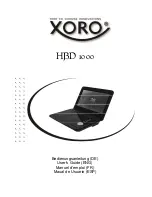
28.5 VDC Ground Power Unit
Models
112850S0000
112850S0100
112850S0200
112850D0000
112850D0100/AV
112850D0100-A5
112850D0200
112860S0000
112860S0100
112860S0100-A4
112860S0100-A6
112860S0200
112860D0000
112860D0100
112860SD100-A5
112860D0200
112860SD200-A5
06/2013 | Rev. 03
Page | 5
3.0
SYSTEM DESCRIPTION
(continued)
3.4
SYSTEM CONTROL
System control consists of one System Interface Board, a firing board, one Operator Panel.
The System Interface Board
handles the master system control function. Control commands from the Control Panel CP are
transmitted to this controller, evaluated and converted into the appropriate actions. Current operating parameters (measured
values etc.) are also evaluated by the System Interface Board. The following measure values are not displayed, but are also
monitored for deviations from the specification:
Input under & over-voltage
Output under & over-voltage
Output overload
Over-temperature
3.5
SAFETY AND PROTECTION
The design philosophy for the 28V DC GPU is that it will endeavor to protect itself at all times. Self-protection is incorporated in
both the hardware and software designs. Where situations arise that could either cause damage to the converter, or endanger
the output load, the general rule is to disconnect and/or shutdown.
For safety of personnel, an Emergency Stop button is fitted local to the Control Panel on the front of the converter cubicle.
3.6
CONTROL AND MONITORING
3.6.1
Power Supplies for Controls & Monitoring
All the electronic cards within the converter receive their power via transformers
.
3.6.2
Internal System Control
System Interface Board
has the function of complete system control.
Control Panel
consists of control and display elements for the user. Commands are analyzed by the system controller and
interpreted into actions. Measurement values for the input and output circuits are processed and displayed.
3.6.3
Converter Operation
As soon as mains incoming power is applied to the control logic the microprocessors commence operating and the internal
function becomes active. Initially their only function is a ‘watchdog operation’ checking for faults within the converter and
monitoring the incoming supply for voltage and frequency deviations. Any faults or deviations detected are reported internally
at the System Interface Board.
3.7
VOLTAGE REGULATION MODE
3.7.1
General
The unit supplies a load which requires a supply voltage with very little deviation. (Normally 28V DC +/- 1%). If a very long
cable is used between the converter and the aircraft (load), a voltage drop will be created which might be greater than the
acceptable voltage tolerance of the aircraft. If this happens, it is no longer possible for many units on the market to provide an
acceptable voltage supply to the aircraft especially under all load conditions.
To overcome this problem, two possibilities are available:
1. The cable between the converter and the load could be designed in such a way that the voltage drop will be decreased so
that the supply voltage is within tolerance range. The amount of copper wires and/or size can be increased or parallel cables
can be used. However there comes a point where the size of the copper wires required could become too heavy or costly, or if
the length of run is so long, that increasing the amount or wire size will still not be enough to keep the tolerance within the
voltage range, for all load conditions.
2. The converter must incorporate a LDC (Line Drop Compensation) system that can provide active compensation so as to
automatically compensate for the voltage drop.
With very long cable runs, parallel cables will increase the wire investment costs dramatically and if flexible aircraft cables are
also used, then parallel cabling might not be possible or practical.
To ensure that the proper voltage is delivered to the aircraft plug under all load conditions, there must be a means of
measuring the voltage at the aircraft plug, and sending those voltage signals back to the converter, so they can be analyzed
and responded to. This requires that signal wires be run between the plug and the converter unit, where again cost and
practicality must be considered.
Summary of Contents for 112850D0000
Page 27: ...APPENDIX I Wiring Diagram and Schedule Single Output...
Page 28: ......
Page 36: ......
Page 40: ......
Page 41: ...APPENDIX II Wiring Diagram and Schedule Dual Output...
Page 42: ......
Page 50: ......
Page 54: ......
Page 55: ...APPENDIX III Declaration of Conformity...
Page 56: ......








































